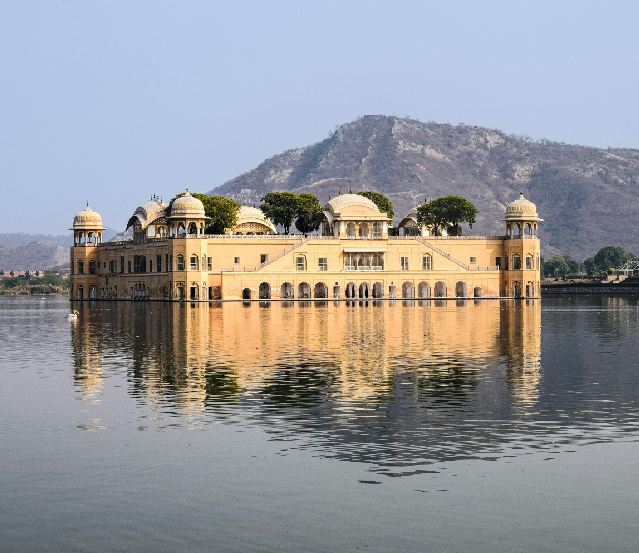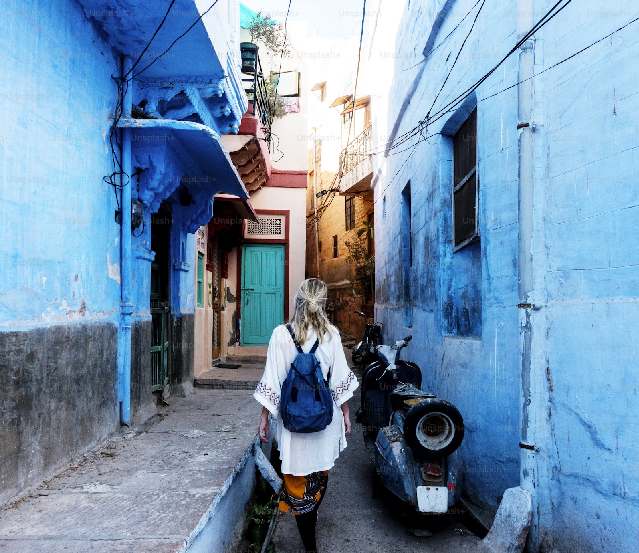Rajasthan The Royal City Tour Packages and Guide
Discover the Rajasthan with our Rajasthan Tour Packages, showcasing the stunning Jaipur and the majestic Mandawa. Experience guided luxury tours and indulge in Rajasthani cuisine — book your adventure today!
In this guide, we’ll delve into Rajasthan’s stunning landmarks, including the magnificent Jaisalmer and the enchanting Jodhpur. We’ll cover how to reach Rajasthan, the best time to visit, and essential packing tips for your trip. Don’t miss out on Rajasthan’s renowned culinary scene, featuring everything from mouthwatering street snacks to exquisite traditional dishes. Join us as we uncover the history and culture of this incredible region!
Rajasthan History
The History of Rajasthan: A Tapestry of Heritage and Resilience
Rajasthan, the land of kings, is steeped in a rich history that weaves together tales of valor, culture, and architectural grandeur. Located in the northwestern part of India, Rajasthan boasts a diverse landscape, from the vast Thar Desert to the lush Aravalli Range. Its history is not just a timeline of events; it is a living legacy that reflects the lives of the many who have inhabited this vibrant state over centuries.
The Formation of Rajasthan: A Historical Overview
Rajasthan’s history dates back to the prehistoric era, with evidence of human habitation found in various archaeological sites. The region was initially settled by tribes like the Bhils and Meenas, who were primarily hunter-gatherers. The first major wave of civilization in Rajasthan can be traced back to the Vedic period, when it became a significant part of the Indo-Aryan culture.
However, it was during the medieval period that Rajasthan began to gain prominence. The formation of various princely states laid the foundation of its political landscape. Prominent Rajput clans such as the Sisodias of Mewar, the Rathores of Marwar, and the Tomars of Gwalior rose to power, establishing formidable kingdoms known for their military prowess and chivalry.
Whom It’s Built For: The Rajput Legacy
The history of Rajasthan is intrinsically linked to the Rajputs, a warrior community that dominated the region. Emerging around the 6th century, the Rajputs were known for their fierce independence, honor, and loyalty. They built majestic forts, palaces, and temples, not only as a display of their wealth and power but also as a means of protection against invasions.
Each Rajput kingdom had its unique culture and traditions, which contributed to the rich tapestry of Rajasthan’s heritage. The Rajputs were not just warriors; they were also patrons of art and architecture. This is evident in the exquisite craftsmanship of the Hawa Mahal in Jaipur and the imposing Mehrangarh Fort in Jodhpur. These structures were built for the Rajput rulers and their families, serving as both residences and fortifications.
The Construction of Architectural Marvels
The architectural marvels of Rajasthan are a testament to the creativity and skill of its artisans. The forts and palaces were built using locally available materials, such as sandstone and marble, and often showcased intricate carvings and elaborate frescoes.
Amer Fort: Constructed in the late 16th century, Amer Fort was built by Raja Man Singh I, a trusted general of Mughal Emperor Akbar. The fort exemplifies a blend of Hindu and Mughal architectural styles, featuring stunning courtyards, gardens, and palatial halls.
Jaisalmer Fort: Known as Sonar Quila or the Golden Fort, Jaisalmer Fort was built in 1156 by Rawal Jaisal. Its honey-gold sandstone walls blend seamlessly with the desert landscape, making it one of the largest fortifications in the world.
Chittorgarh Fort: One of the largest forts in India, Chittorgarh Fort is a symbol of Rajput valor. Built in the 7th century, it witnessed several battles and is famous for the legendary tales of Rani Padmini, who chose self-immolation over capture.
These forts were not just military strongholds; they were also centers of administration and culture, where art, literature, and music flourished.
The Purpose Behind the Construction
The construction of these architectural masterpieces served multiple purposes:
Defense: The tumultuous history of Rajasthan, marked by invasions from Mughals, Afghans, and other forces, necessitated the need for robust fortifications. The forts provided security to the rulers and their subjects.
Symbol of Power: For the Rajput kings, the grandeur of their forts and palaces was a reflection of their power and influence. These structures were often strategically located to assert dominance over trade routes and surrounding territories.
Cultural Hub: The palaces served as centers for cultural exchange, where art, literature, and music thrived. They hosted grand festivals and royal ceremonies, showcasing the rich traditions of Rajasthan.
The Impact of Colonialism
The British colonial period marked a significant turning point in Rajasthan’s history. While the Rajput states initially maintained a degree of autonomy, the British gradually asserted control over the region. The Treaty of 1818 formalized British influence, and many princely states became part of the British Raj.
Despite the challenges posed by colonial rule, Rajasthan’s cultural identity remained resilient. The British recognized the allure of Rajasthan’s history and architecture, often promoting it as a tourist destination. This period saw the restoration of many forts and palaces, which would later become major attractions.
Post-Independence Era and Modern Rajasthan
With India’s independence in 1947, Rajasthan underwent a significant transformation. The princely states were merged to form the state of Rajasthan in 1956, creating a new political landscape. The integration brought about challenges, including issues of identity and governance, but also opportunities for development.
Today, Rajasthan stands as a vibrant state, celebrating its rich history while embracing modernity. The forts and palaces, once symbols of power, have become repositories of heritage and culture. They attract millions of tourists annually, contributing to the state’s economy and cultural preservation.
Cultural Heritage and Festivals
Rajasthan is not just about forts and palaces; it is also a land of vibrant festivals and traditions. The rich cultural tapestry is evident in its folk music, dance forms, and colorful attire. Festivals like Diwali, Teej, and the Desert Festival celebrate the state’s diverse heritage.
The folk traditions of Rajasthan, including Ghoomar and Kalbeliya dances, offer a glimpse into the lives of its people. The craftsmanship in textiles, pottery, and jewelry reflects the artistic legacy that has been passed down through generations.
Conclusion: A Living Legacy
Rajasthan’s history is a complex narrative of resilience, valor, and culture. From the ancient tribes to the powerful Rajputs and the impact of colonialism, the state has continuously evolved while preserving its unique identity. The forts and palaces stand as silent witnesses to a glorious past, drawing visitors from around the world to experience the magic of Rajasthan.
As Rajasthan moves forward, it carries with it the weight of its history—a history that is not just a collection of events but a vibrant tapestry that continues to inspire and resonate with generations. The state’s commitment to preserving its heritage while adapting to modern challenges ensures that the essence of Rajasthan will endure, captivating hearts and minds for years to come.
Best Time To Visit Rajasthan
The Best Time to Visit Rajasthan: A Deep Dive into the Climate
Rajasthan, known for its rich history, stunning architecture, and vibrant culture, attracts travelers from all over the world. However, planning your trip requires a keen understanding of the state’s climate throughout the year. The best time to visit Rajasthan can significantly enhance your experience, allowing you to explore its majestic forts, colorful markets, and traditional festivals comfortably. In this article, we’ll take a detailed look at the climate in Rajasthan month by month and identify the best months to visit.
Rajasthan Climate Overview
Rajasthan experiences a diverse climate influenced by its geographical features. The state can be broadly categorized into three main seasons: summer, monsoon, and winter. Each season has its unique characteristics, making certain months more suitable for tourism than others.
Summer (March to June)
March: As winter bids farewell, March marks the transition into warmer weather. Temperatures begin to rise, with daytime highs averaging around 30°C (86°F) to 35°C (95°F). Nights remain relatively cool, making March one of the most pleasant months to visit. This month is ideal for exploring popular cities like Jaipur, Udaipur, and Jodhpur, as the weather is still manageable.
April: The heat intensifies in April, with temperatures soaring to 35°C (95°F) and beyond. The days can become quite hot, making outdoor activities less comfortable, especially during midday. However, the evenings offer a slight relief, with cooler temperatures. This month sees fewer tourists, so if you prefer a quieter experience, April could still be an option, provided you plan your outdoor activities for early mornings or late evenings.
May: May is characterized by extreme heat, with temperatures often exceeding 40°C (104°F). The dry and arid conditions can be quite challenging for travelers. If you must visit during this month, prioritize early morning or late evening excursions. Staying hydrated and avoiding outdoor activities during peak sun hours is crucial.
June: June marks the onset of the monsoon season. However, before the rains arrive, the heat continues, with temperatures remaining high. By the end of the month, the first monsoon showers bring some relief from the scorching heat. Early June can still be quite hot, so it’s best to plan your visits around the latter half when the weather begins to cool down.
Monsoon (July to September)
July: The monsoon is in full swing in July, bringing much-needed relief to the parched landscapes of Rajasthan. Rainfall varies across the state, with some areas receiving substantial precipitation. While the temperatures drop to around 30°C (86°F), the humidity increases, which can make the weather feel muggy. This month is less crowded with tourists, and the lush green landscapes offer a different perspective of Rajasthan’s beauty.
August: August continues the monsoon trend, with moderate rainfall and slightly cooler temperatures. The average temperatures hover around 28°C (82°F) to 30°C (86°F). While the rains can disrupt travel plans, they also rejuvenate the environment, making it a visually appealing time to visit. If you’re willing to brave the occasional downpour, August can be a rewarding time for nature lovers.
September: By September, the monsoon season starts to wane. The rainfall decreases, and the humidity begins to drop. Temperatures gradually rise, averaging around 30°C (86°F). This month is a great time to visit Rajasthan if you want to witness the state’s natural beauty after the rains. The landscape is vibrant and lush, providing a scenic backdrop for sightseeing.
Winter (October to February)
October: October marks the beginning of the winter season in Rajasthan. The weather is pleasantly cool, with daytime temperatures ranging from 25°C (77°F) to 30°C (86°F). Nights can get chilly, especially towards the end of the month. October is an excellent time to explore Rajasthan, as the climate is ideal for outdoor activities and sightseeing. The festival of Diwali often falls in this month, adding a festive spirit to your visit.
November: November offers even cooler temperatures, with highs around 25°C (77°F) and lows dropping to 10°C (50°F). This month is perfect for sightseeing, with pleasant weather that encourages exploration. The state is less crowded compared to peak tourist seasons, allowing for a more relaxed experience. November also sees several cultural events and fairs, making it an attractive time for travelers.
December: December is one of the best months to visit Rajasthan. With daytime temperatures averaging between 20°C (68°F) to 25°C (77°F) and chilly nights, the weather is ideal for outdoor activities. Popular destinations can be busy during this time, especially around Christmas and New Year, but the festive atmosphere adds to the charm. You can enjoy the rich cultural experiences and festivals during this peak tourist season.
January: January continues the winter season with cool and pleasant weather. Daytime temperatures hover around 20°C (68°F), while nights can drop to 5°C (41°F) or lower in some areas. January is a great time to visit Rajasthan, especially for those who enjoy cooler weather. It’s perfect for exploring forts and palaces, as well as participating in various festivals and events that showcase the local culture.
February: February marks the end of winter and the gradual warming of temperatures. Daytime highs range from 25°C (77°F) to 30°C (86°F), while nights remain cool. This month is still considered one of the best times to visit Rajasthan, as the weather is comfortable for sightseeing. It’s also a great time to witness the vibrant spring festivals celebrated in the region.
Best Time to Visit Rajasthan
Considering the above climatic conditions, the best time to visit Rajasthan is from October to March. This period encompasses the winter months when the weather is most favorable for travel. The pleasant temperatures and clear skies provide an ideal backdrop for exploring the state’s many attractions.
- October: Ideal for witnessing the beautiful landscapes post-monsoon and experiencing local festivals.
- November: Offers comfortable weather and fewer crowds.
- December: Perfect for enjoying outdoor activities and cultural experiences during the holiday season.
- January: Best for sightseeing in pleasant weather, with the added advantage of witnessing winter festivals.
- February: A great time to enjoy mild weather and participate in various cultural events.
Tips for Visiting Rajasthan
- Dress Appropriately: Rajasthan can experience extreme temperatures, so it’s essential to dress in layers, especially in winter. Lightweight, breathable fabrics are best for summer, while warmer clothing is advisable for the chilly nights in winter.
- Stay Hydrated: Regardless of the season, staying hydrated is crucial, especially during the hot summer months. Carry water bottles and drink plenty of fluids.
- Plan Activities Wisely: During the peak summer months, schedule outdoor activities for early morning or late evening to avoid the midday heat. In winter, afternoons are perfect for sightseeing, while mornings and evenings can be quite cool.
- Book in Advance: The peak tourist season can lead to crowded attractions and fully booked accommodations. It’s wise to book your hotels and tours in advance to ensure a smooth experience.
- Explore Local Culture: Regardless of when you visit, take the time to explore Rajasthan’s rich culture through its festivals, local cuisine, and crafts. Engaging with the local community will enhance your travel experience.
Conclusion
Rajasthan’s climate varies significantly throughout the year, offering distinct experiences based on the season you choose to visit. The best months to visit Rajasthan are undoubtedly from October to March when the weather is most conducive to exploration and outdoor activities. Understanding the climate variations will help you plan your trip effectively, ensuring you make the most of your journey through this magnificent state.
How To Reach Rajasthan
How to Reach Rajasthan: A Comprehensive Guide
Rajasthan, the vibrant land of kings, is a popular destination for travelers seeking rich cultural experiences, majestic forts, and stunning landscapes. Planning your journey to this enchanting state requires understanding the best ways to reach Rajasthan from various parts of India. In this article, we will explore how to reach Rajasthan from Delhi, Varanasi, and Kerala, providing insights into transportation options and approximate costs.
Overview of Transportation Options
When considering how to reach Rajasthan, travelers have several options, including air travel, trains, and buses. Each mode of transportation has its advantages, depending on your budget, time constraints, and personal preferences.
Air Travel: Rajasthan is served by several airports, with Jaipur International Airport being the busiest. Udaipur, Jodhpur, and Jaisalmer also have airports, making air travel a convenient option for many.
Train Travel: India’s extensive railway network connects Rajasthan with major cities across the country. Trains are often the most economical and scenic way to travel, offering a chance to experience the local culture.
Bus Services: State-run and private bus services operate across Rajasthan, providing a budget-friendly way to travel between cities.
Self-Drive: For those who prefer flexibility, renting a car or hiring a taxi can provide a unique road trip experience, allowing you to explore at your own pace.
Now, let’s look at how to reach Rajasthan from specific locations: Delhi, Varanasi, and Kerala.
How to Reach Rajasthan from Delhi
By Air
Flight Duration: Approximately 1 hour
Delhi is well-connected to various cities in Rajasthan, particularly Jaipur, the state capital. Major airlines operate multiple flights daily, making this the fastest way to reach Rajasthan.
Cost:
- Airfare: Round-trip tickets from Delhi to Jaipur can range from ₹3,000 to ₹7,000, depending on how far in advance you book and the time of travel. Booking in advance often yields better prices.
By Train
Travel Duration: Approximately 4 to 6 hours
Trains are a popular choice for travelers, with several options available from Delhi to Jaipur. The Ajmer Shatabdi Express and Rajasthan Sampark Kranti Express are among the most preferred trains.
Cost:
- Ticket Prices: Sleeper class tickets cost around ₹500, while AC Chair Car tickets are approximately ₹1,200 to ₹1,800. Booking through the IRCTC website is recommended for ease.
By Bus
Travel Duration: Approximately 5 to 6 hours
Buses are another viable option, with both state-run and private operators offering services from Delhi to Jaipur. Buses are typically comfortable, with options ranging from standard to luxury coaches.
Cost:
- Bus Fare: Prices vary, with standard buses costing around ₹500 to ₹700 and luxury buses ranging from ₹1,000 to ₹1,500.
Summary
For travelers in Delhi, the best way to reach Rajasthan is by taking a flight for speed or a train for an authentic experience. Buses provide an economical option for those looking to save money.
How to Reach Rajasthan from Varanasi
By Air
Flight Duration: Approximately 1.5 to 2 hours
Varanasi does not have direct flights to many cities in Rajasthan, but there are flights available to Jaipur, Udaipur, and Jodhpur with a layover.
Cost:
- Airfare: Round-trip fares from Varanasi to Jaipur can range from ₹4,000 to ₹8,000, depending on the airlines and booking time.
By Train
Travel Duration: Approximately 14 to 16 hours
Traveling by train is a popular option, with direct trains running from Varanasi to Jaipur, Udaipur, and Jodhpur. The Varanasi-Jaipur Express is a notable service.
Cost:
- Ticket Prices: Sleeper class tickets are around ₹600, while AC 3-tier tickets can cost between ₹1,500 to ₹2,500.
By Bus
Travel Duration: Approximately 18 to 20 hours
Buses from Varanasi to Rajasthan are less frequent and often require transfers. However, some private operators do provide services to Jaipur and other cities.
Cost:
- Bus Fare: Prices can range from ₹800 to ₹1,200, but the long travel time makes this option less appealing.
Summary
For travelers in Varanasi, taking a train is the best way to reach Rajasthan, providing a balance between comfort and cost. Flights are faster but may require connections.
How to Reach Rajasthan from Kerala
By Air
Flight Duration: Approximately 3 to 4 hours
Kerala has several international airports, with Kochi International Airport being the largest. Direct flights to Jaipur, Udaipur, and Jodhpur are available, making air travel a convenient option.
Cost:
- Airfare: Round-trip tickets from Kochi to Jaipur can range from ₹5,000 to ₹12,000. Booking well in advance can help secure lower fares.
By Train
Travel Duration: Approximately 30 to 35 hours
Traveling by train from Kerala to Rajasthan is a longer journey, often requiring transfers. Direct trains to Jaipur and other cities may take time, but the journey can be scenic.
Cost:
- Ticket Prices: Sleeper class tickets cost around ₹1,200 to ₹1,500, while AC 3-tier tickets can range from ₹2,500 to ₹4,000.
By Bus
Travel Duration: Not Recommended
Buses from Kerala to Rajasthan are not practical due to the long distance. While some private operators may offer services, it is advisable to avoid this option due to the time involved.
Summary
For travelers in Kerala, the best way to reach Rajasthan is by air, given the distance involved. Train travel is an option but requires significant time and planning.
Additional Considerations
Travel Tips
Book in Advance: Regardless of the mode of transport, booking your tickets in advance can save you money and ensure availability, especially during peak tourist seasons.
Check the Weather: Be aware of the climate in Rajasthan during your visit. The best time to explore is typically from October to March when the weather is pleasant.
Plan Your Itinerary: Depending on your entry point into Rajasthan, plan an itinerary that allows you to visit major attractions efficiently, such as Jaipur, Udaipur, Jodhpur, and more.
Conclusion
Rajasthan is an accessible destination from various parts of India, each offering unique travel experiences. Whether you’re arriving from Delhi, Varanasi, or Kerala, understanding the best ways to reach Rajasthan can enhance your journey. For quick travel, air travel is the fastest option, while trains offer a blend of comfort and authenticity, allowing you to experience the local culture. Buses are an economical choice, particularly for shorter distances.
By planning ahead and considering your travel preferences, you can ensure a memorable adventure in the colorful heart of India. Rajasthan awaits, filled with history, culture, and breathtaking landscapes!
Famous Places In Rajasthan
Exploring the Famous Places of Rajasthan
Rajasthan, known as the “Land of Kings,” is a state rich in history, culture, and breathtaking landscapes. From majestic forts to serene lakes and vibrant markets, Rajasthan offers a plethora of attractions that showcase its royal heritage. In this article, we will explore some of the most famous places in Rajasthan, including how to reach them, ticket prices, opening and closing times, and any relevant holidays.
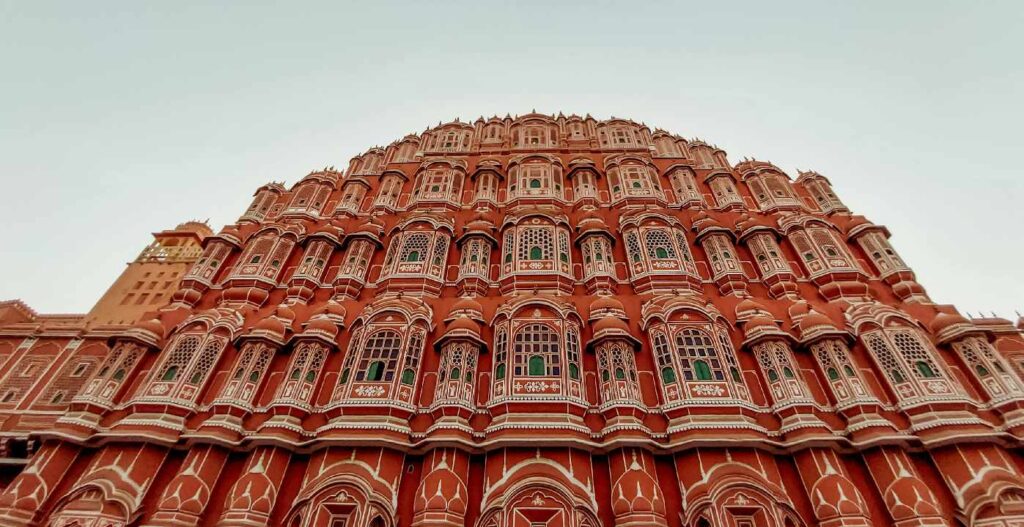
1. Jaipur: The Pink City
Overview
Jaipur, the capital of Rajasthan, is renowned for its beautiful architecture and rich history. The city is home to several iconic landmarks, including the Hawa Mahal, Amer Fort, and City Palace.
How to Reach
- By Air: Jaipur International Airport connects the city to major domestic and international destinations.
- By Train: Jaipur Railway Station is well-connected to cities like Delhi, Mumbai, and Kolkata.
- By Road: The city is accessible via a network of highways. Buses and taxis operate from various cities in Rajasthan.
Famous Attractions
Hawa Mahal: The Palace of Winds, known for its unique façade.
- Ticket Price: ₹50 for Indians, ₹200 for foreigners.
- Opening Hours: 9 AM to 5 PM.
- Closed: Closed on national holidays.
Amer Fort: A majestic fort overlooking Maota Lake.
- Ticket Price: ₹100 for Indians, ₹500 for foreigners.
- Opening Hours: 8 AM to 5:30 PM.
- Closed: Closed on Diwali.
City Palace: A royal residence with museums and courtyards.
- Ticket Price: ₹200 for Indians, ₹500 for foreigners.
- Opening Hours: 9:30 AM to 5 PM.
- Closed: Closed on national holidays.
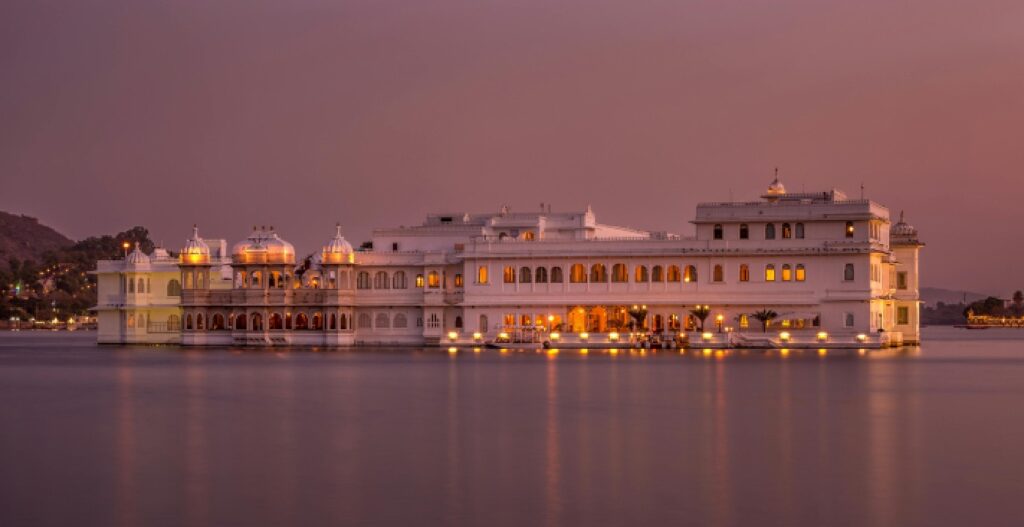
2. Udaipur: The City of Lakes
Overview
Udaipur is often referred to as the “Venice of the East” due to its stunning lakes and palaces. The city is famous for the City Palace, Lake Pichola, and Jag Mandir.
How to Reach
- By Air: Maharana Pratap Airport connects Udaipur to major Indian cities.
- By Train: Udaipur Railway Station has connections to cities like Jaipur and Delhi.
- By Road: Well-maintained roads link Udaipur to various cities in Rajasthan and neighboring states.
Famous Attractions
City Palace: A magnificent complex overlooking Lake Pichola.
- Ticket Price: ₹300 for Indians, ₹600 for foreigners.
- Opening Hours: 9 AM to 9 PM.
- Closed: Closed on national holidays.
Lake Pichola: A picturesque lake ideal for boat rides.
- Ticket Price: Boat ride costs approximately ₹300 per person.
- Opening Hours: Boat rides generally available from 9 AM to 6 PM.
- Closed: Not closed on any specific holidays.
Jag Mandir: An exquisite island palace on Lake Pichola.
- Ticket Price: Entry is included in the boat ride fare.
- Opening Hours: 10 AM to 6 PM.
- Closed: Closed during monsoon (July to September).
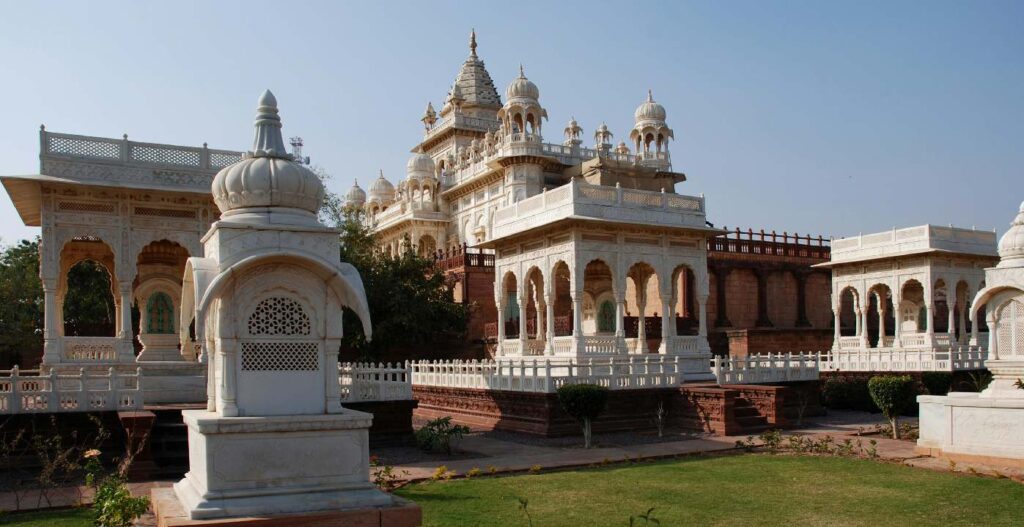
3. Jodhpur: The Blue City
Overview
Jodhpur, famously known as the “Blue City,” is characterized by its blue-painted houses and the majestic Mehrangarh Fort.
How to Reach
- By Air: Jodhpur Airport has flights to major cities like Delhi and Mumbai.
- By Train: Jodhpur Junction is a key railway station with numerous connections.
- By Road: National and state highways connect Jodhpur to other cities.
Famous Attractions
Mehrangarh Fort: A massive fort with stunning views of the city.
- Ticket Price: ₹100 for Indians, ₹600 for foreigners.
- Opening Hours: 9 AM to 5:30 PM.
- Closed: Closed on national holidays.
Umaid Bhawan Palace: A lavish palace turned heritage hotel.
- Ticket Price: ₹30 for Indians, ₹100 for foreigners (museum entry only).
- Opening Hours: 9 AM to 5 PM.
- Closed: Closed on national holidays.
Jaswant Thada: A beautiful marble cenotaph near Mehrangarh Fort.
- Ticket Price: ₹30 for Indians, ₹50 for foreigners.
- Opening Hours: 9 AM to 5 PM.
- Closed: Closed on national holidays.
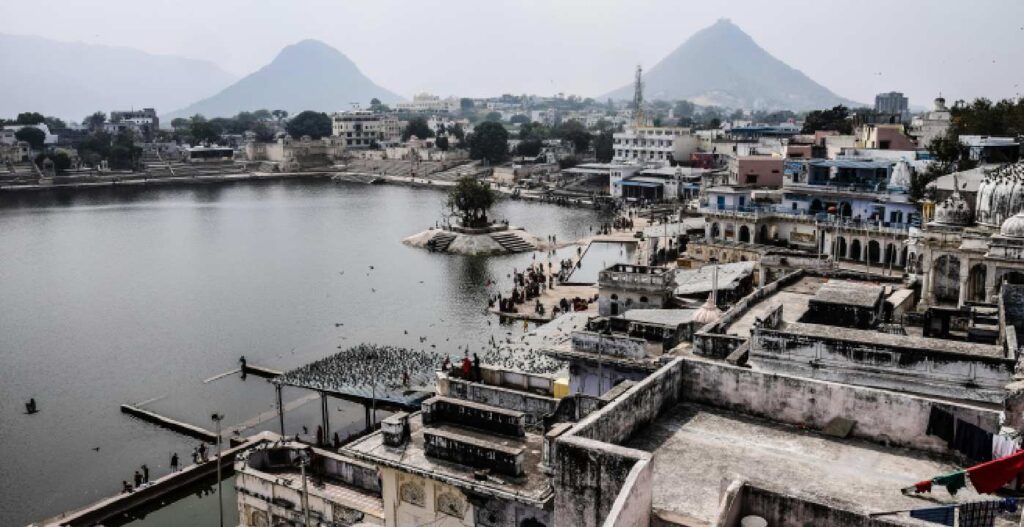
4. Pushkar: The Holy City
Overview
Pushkar is famous for its sacred lake, Brahma Temple, and vibrant annual camel fair. It is a significant pilgrimage site for Hindus.
How to Reach
- By Air: The nearest airport is in Jaipur, about 150 km away.
- By Train: Pushkar does not have a railway station; the nearest station is Ajmer, 14 km away.
- By Road: Well-connected by roads to major cities, including Jaipur and Ajmer.
Famous Attractions
Brahma Temple: One of the few temples dedicated to Lord Brahma.
- Ticket Price: Free entry.
- Opening Hours: 6 AM to 8 PM.
- Closed: Closed on full moon days and during the Pushkar Fair.
Pushkar Lake: A holy lake surrounded by ghats.
- Ticket Price: Free entry.
- Opening Hours: Open 24 hours.
- Closed: No specific holidays.
Pushkar Camel Fair: An annual event in November showcasing camel trading, cultural performances, and competitions.
- Ticket Price: Entry fees may vary depending on events; typically around ₹100.
- Opening Hours: Varies based on event schedule.
- Closed: No closure, but events occur annually.
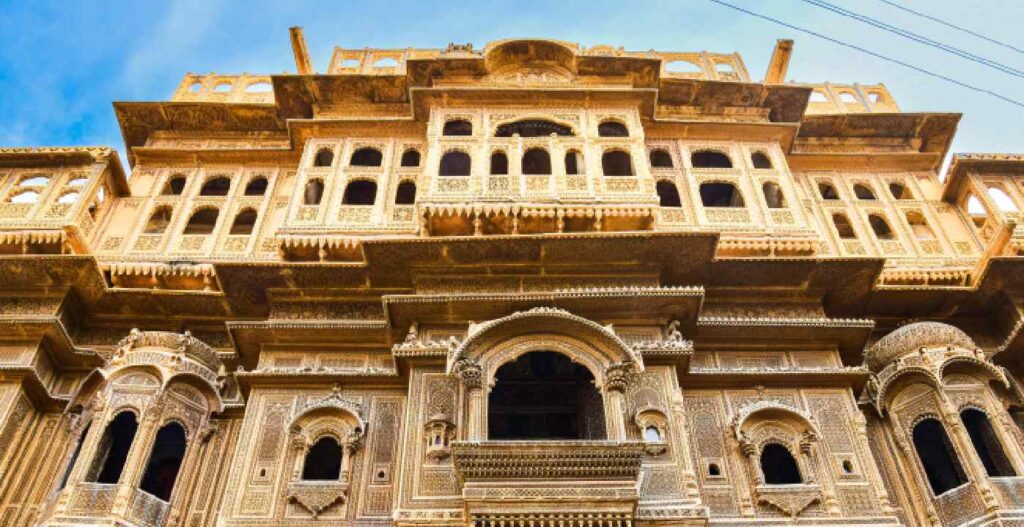
5. Jaisalmer: The Golden City
Overview
Jaisalmer is known for its stunning sandstone architecture and proximity to the Thar Desert. The Jaisalmer Fort, a UNESCO World Heritage Site, is the highlight of the city.
How to Reach
- By Air: Jaisalmer Airport has limited flights, primarily from Delhi and Jaipur.
- By Train: Jaisalmer Railway Station connects to various cities.
- By Road: Well-connected by roads, making it accessible via bus or taxi from nearby cities.
Famous Attractions
Jaisalmer Fort: A living fort with shops, hotels, and residences.
- Ticket Price: ₹50 for Indians, ₹100 for foreigners (includes a guided tour).
- Opening Hours: 9 AM to 5 PM.
- Closed: Closed on national holidays.
Patwon Ki Haveli: A stunning collection of havelis showcasing intricate architecture.
- Ticket Price: ₹100 for Indians, ₹200 for foreigners.
- Opening Hours: 9 AM to 6 PM.
- Closed: Closed on national holidays.
Sam Sand Dunes: Popular for camel safaris and desert experiences.
- Ticket Price: ₹500 for camel rides (prices vary based on packages).
- Opening Hours: 4 PM to 10 PM.
- Closed: Not closed on specific holidays, but services may vary.

6. Ranthambore National Park: A Wildlife Sanctuary
Overview
Ranthambore National Park is one of the largest national parks in northern India, famous for its Bengal tigers and diverse wildlife. It is a popular destination for wildlife enthusiasts and photographers.
How to Reach
- By Air: The nearest airport is in Jaipur, about 180 km away.
- By Train: Sawai Madhopur is the nearest railway station, just 10 km from the park.
- By Road: Well-connected via state highways and roads.
Famous Attractions
- Ranthambore National Park: Home to a variety of flora and fauna, including tigers.
- Ticket Price: ₹50 for Indians, ₹100 for foreigners (entry fee).
- Safari Prices: Jeep safaris range from ₹3,000 to ₹5,000 depending on the vehicle and booking.
- Opening Hours: 6:30 AM to 10:00 AM and 3:30 PM to 6:30 PM (timings may vary based on season).
- Closed: The park is closed during the monsoon season (from July to September).
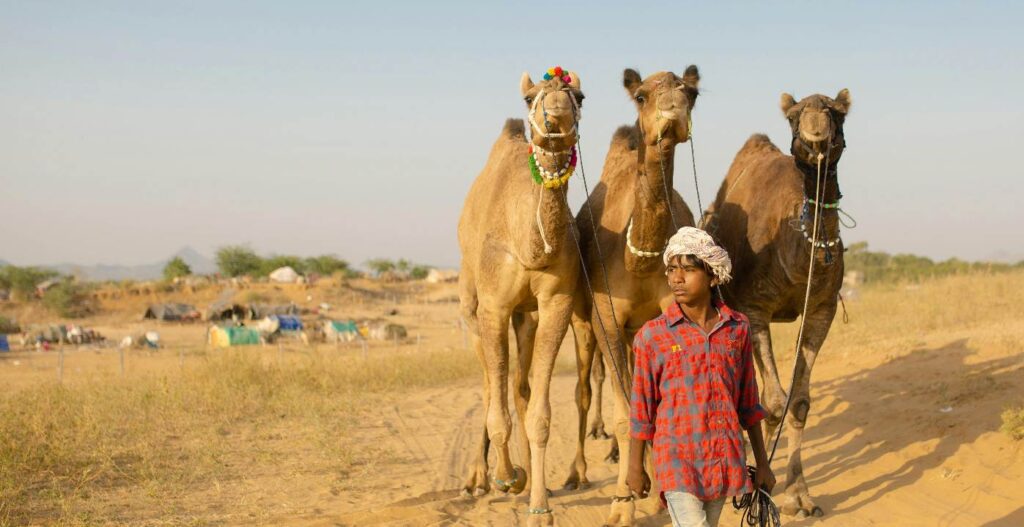
7. Bikaner: The Camel City
Overview
Bikaner is famous for its forts, palaces, and the annual Camel Festival. The Junagarh Fort and Karni Mata Temple are major attractions.
How to Reach
- By Air: Bikaner Airport has limited flights; the nearest major airport is in Jodhpur.
- By Train: Bikaner Railway Station is well-connected to various cities.
- By Road: The city is accessible via national highways.
Famous Attractions
Junagarh Fort: A stunning fort with impressive architecture.
- Ticket Price: ₹50 for Indians, ₹300 for foreigners.
- Opening Hours: 10 AM to 4:30 PM.
- Closed: Closed on national holidays.
Karni Mata Temple: Known as the Rat Temple, it attracts pilgrims and tourists alike.
- Ticket Price: Free entry.
- Opening Hours: 24 hours.
- Closed: No specific closure days.
Bikaner Camel Festival: An annual event held in January featuring camel races, cultural performances, and competitions.
- Ticket Price: Entry fees vary depending on the events; typically around ₹50.
- Opening Hours: Varies based on the event schedule.
- Closed: No closure; annual event.
Conclusion
Rajasthan is a treasure trove of cultural heritage and natural beauty, with each city offering a unique experience. From the majestic forts of Jaipur and Jodhpur to the tranquil lakes of Udaipur and the golden sands of Jaisalmer, the famous places of Rajasthan provide unforgettable adventures for every traveler. When planning your visit, consider the various modes of transportation available, ticket prices, and timings for each attraction. By understanding these details, you can create an enriching itinerary that captures the essence of Rajasthan.
Whether you’re exploring ancient palaces, indulging in local cuisine, or participating in vibrant festivals, Rajasthan promises a journey filled with memories that will last a lifetime. Embrace the spirit of this remarkable state, and immerse yourself in its unparalleled charm!
Famous Food Of Rajasthan
Famous Food of Rajasthan
Rajasthan, known for its rich culture and vibrant heritage, is equally celebrated for its diverse and flavorful cuisine. The food of Rajasthan reflects the state’s history, geography, and the traditions of its people, offering a unique culinary experience that captivates locals and tourists alike. From spicy curries to delightful sweets, Rajasthani cuisine has something to satisfy every palate. In this article, we will explore some of the most famous foods of Rajasthan, why they are so beloved, and an overview of their prices.
Why Rajasthani Food is Famous
Rajasthani cuisine stands out for several compelling reasons:
Cultural Heritage: The culinary traditions of Rajasthan are deeply rooted in its history. Many dishes have been passed down through generations, influenced by the royal kitchens of the erstwhile kings and the simple lifestyles of desert-dwelling communities.
Geographical Influences: The arid climate of Rajasthan affects the types of ingredients used in its cuisine. With limited water resources, Rajasthani cooking emphasizes ingredients that can be stored for long periods, such as lentils, legumes, and spices. This has led to the creation of dishes that are hearty and nutritious.
Rich Flavors and Spices: Rajasthani food is known for its bold flavors, characterized by the generous use of spices such as cumin, coriander, and turmeric. The addition of dried fruits and nuts adds depth to many dishes, making them rich and satisfying.
Vegetarian Variety: Influenced by Jainism and the prevalence of vegetarianism in the region, Rajasthani cuisine boasts an impressive variety of vegetarian dishes. These meals are not only hearty but also creatively prepared, showcasing the versatility of local ingredients.
Traditional Cooking Techniques: Many Rajasthani dishes are prepared using traditional methods, such as slow cooking in earthen pots, which enhances the flavors and aromas, creating a unique culinary experience.
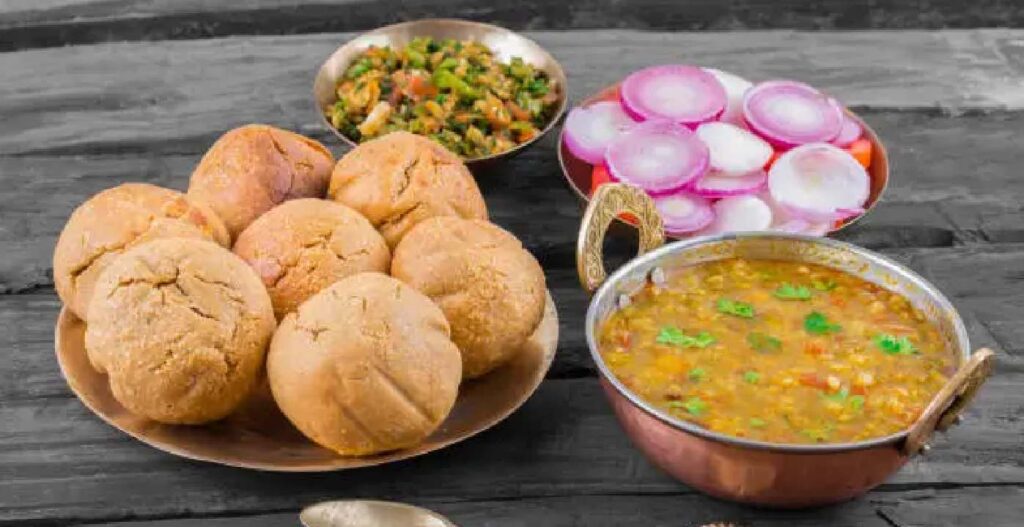
Famous Dishes of Rajasthan
1. Dal Baati Churma
Overview: Dal Baati Churma is arguably the most iconic dish of Rajasthan. It consists of baked wheat balls (baati) served with a spicy lentil curry (dal) and sweet crushed wheat (churma) mixed with jaggery and ghee.
Why It’s Famous: This dish is a complete meal that showcases the culinary diversity of Rajasthan. The combination of spicy, savory, and sweet flavors is a beloved staple, especially in rural areas.
Price: A typical serving of Dal Baati Churma costs around ₹150 to ₹300 in local restaurants.

2. Gatte ki Sabzi
Overview: Gatte ki Sabzi is a delicious curry made from gram flour (besan) dumplings that are boiled and then cooked in a tangy yogurt-based sauce.
Why It’s Famous: This dish is known for its rich flavor and unique texture. The gatte, when paired with the spicy gravy, create a comforting and hearty meal.
Price: Expect to pay about ₹100 to ₹200 for a serving in a restaurant.
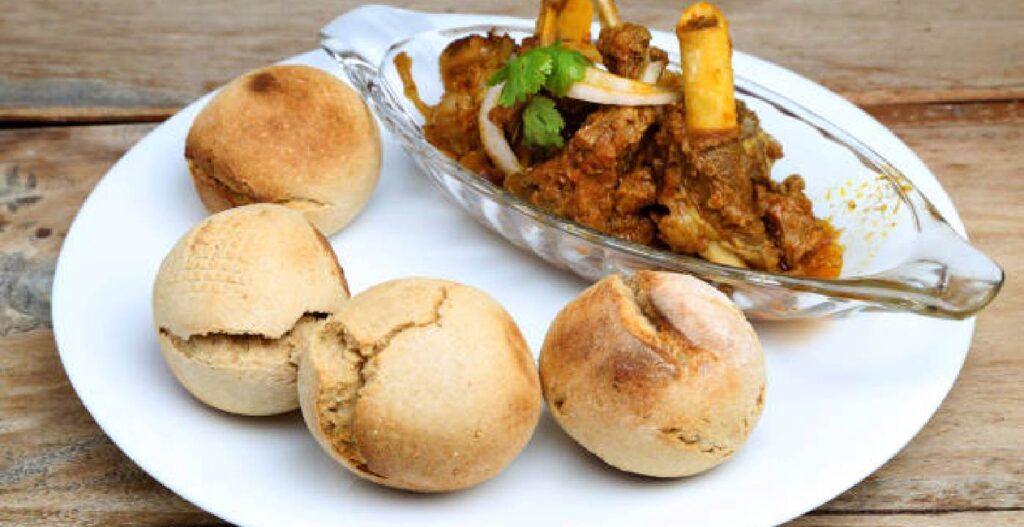
3. Laal Maas
Overview: Laal Maas is a fiery meat curry made with mutton, slow-cooked with red chilies and spices. The dish is traditionally served with rice or flatbreads.
Why It’s Famous: This dish is a favorite among spice lovers and reflects the bold culinary heritage of Rajasthan. The deep red color and robust flavors make it a must-try for meat enthusiasts.
Price: A serving of Laal Maas can range from ₹300 to ₹500, depending on the establishment.
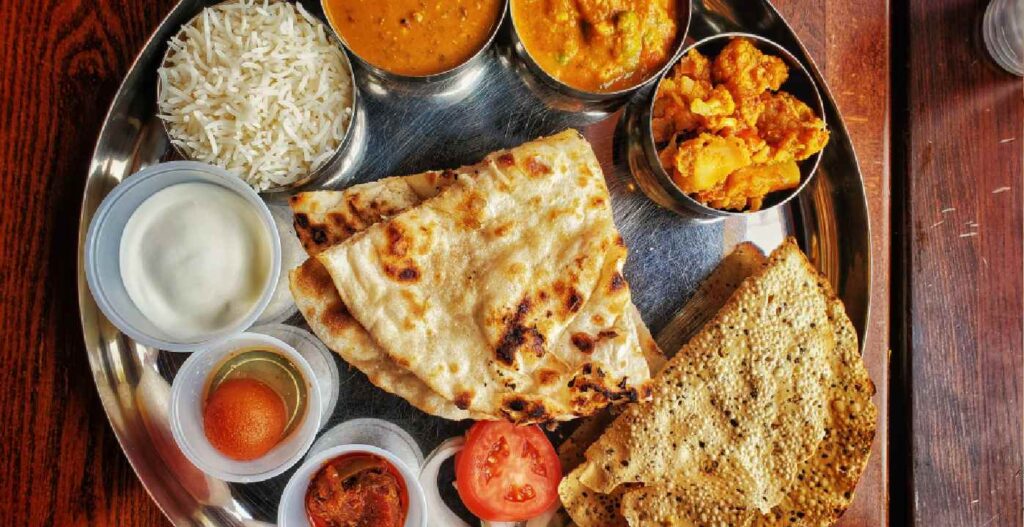
4. Rajasthani Thali
Overview: A Rajasthani Thali is a lavish platter that includes a variety of dishes, such as dal, baati, gatte, ker sangri, raita, and sweets. It offers a comprehensive taste of Rajasthani cuisine.
Why It’s Famous: The thali showcases the diversity of flavors and textures in Rajasthani food, making it a perfect choice for those looking to sample multiple dishes at once.
Price: A Rajasthani Thali can cost anywhere from ₹300 to ₹700, depending on the restaurant.

6. Jalebi and Ghevar
Overview: For dessert, Rajasthani Jalebi (crispy fried sweets soaked in sugar syrup) and Ghevar (a disc-shaped sweet made from flour and soaked in syrup) are iconic treats.
Why They’re Famous: These sweets are synonymous with celebrations and festivals in Rajasthan, enjoyed for their unique flavors and textures.
Price: A plate of Jalebi can cost around ₹50 to ₹100, while Ghevar typically costs ₹100 to ₹200.
Conclusion
Rajasthani cuisine is a vibrant reflection of the state’s culture, history, and geography. With its rich flavors, diverse dishes, and innovative use of ingredients, it offers a culinary journey that is both satisfying and memorable. Whether you’re indulging in the iconic Dal Baati Churma or exploring the fiery notes of Laal Maas, each dish tells a story of tradition and passion.
As you plan your visit to Rajasthan, make sure to savor its famous foods, as they are an integral part of the experience. With reasonable prices and an abundance of flavors, Rajasthani cuisine is sure to leave a lasting impression on your palate and your heart.
What To Take In Rajasthan Or Not
What to Take on a Rajasthan Tour: A Comprehensive Guide
Rajasthan, the vibrant land of kings, is renowned for its majestic palaces, historic forts, and rich cultural heritage. Planning a trip to this diverse region requires thoughtful packing and an understanding of what to wear and where to stay. In this article, we will explore what to take on your Rajasthan tour, including clothing suitable for different seasons and a rundown of luxury hotels and hostels, along with their prices.
Packing Essentials for Rajasthan
Clothing Considerations
Rajasthan experiences extreme temperatures, with scorching summers, mild winters, and pleasant weather during the monsoon. Here’s a seasonal breakdown of what to wear:
1. Summer (March to June)
What to Wear:
- Lightweight Fabrics: Opt for breathable materials like cotton and linen. Loose-fitting clothes help keep you cool.
- Light Colors: Light colors reflect sunlight, keeping you cooler. Consider wearing whites, pastels, or light earth tones.
- Sun Protection: A wide-brimmed hat, sunglasses, and a light scarf can protect against the harsh sun.
- Footwear: Comfortable sandals or breathable sneakers are ideal for walking.
Packing Tips:
- Sunscreen: High SPF sunscreen is essential.
- Reusable Water Bottle: Stay hydrated in the heat.
- Light Jacket: While daytime can be hot, evenings may cool down, especially in desert areas.
2. Monsoon (July to September)
What to Wear:
- Quick-Drying Fabrics: Moisture-wicking clothes are recommended as the humidity rises.
- Waterproof Jacket: A lightweight, packable rain jacket or poncho can be invaluable.
- Comfortable Footwear: Waterproof sandals or shoes are best, especially in areas with heavy rainfall.
Packing Tips:
- Umbrella: A compact umbrella can be helpful during sudden downpours.
- Insect Repellent: Mosquitoes are prevalent during the monsoon, so bring insect repellent.
3. Winter (October to February)
What to Wear:
- Layered Clothing: Mornings and nights can be chilly, so layer up. T-shirts, long-sleeved shirts, and light sweaters work well.
- Warm Accessories: Consider bringing a shawl or scarf, especially for desert areas where temperatures drop at night.
- Comfortable Shoes: Closed-toe shoes or boots are advisable for warmth.
Packing Tips:
- Warm Jacket: A light to medium jacket is essential for evenings and early mornings.
- Thermal Wear: For those particularly sensitive to cold, thermal undergarments can be useful.
Accommodations in Rajasthan
Luxury Hotels
Rajasthan boasts some of India’s most opulent hotels, many of which are former palaces and forts that offer a regal experience. Here are a few notable luxury hotels:
1. Taj Lake Palace, Udaipur
- Overview: This stunning palace floats on Lake Pichola and offers a magical experience.
- Price: Rooms start at approximately ₹20,000 per night.
- Amenities: Spa, fine dining, boat rides, and heritage tours.
2. Rambagh Palace, Jaipur
- Overview: Once the residence of the Maharaja of Jaipur, this palace is now a luxurious hotel.
- Price: Rates begin at around ₹18,000 per night.
- Amenities: Swimming pool, spa, multiple dining options, and a royal experience.
3. Umaid Bhawan Palace, Jodhpur
- Overview: A heritage hotel that was once the residence of the Maharaja of Jodhpur, it offers lavish accommodations.
- Price: Starting around ₹15,000 per night.
- Amenities: Pool, spa, gardens, and a museum.
4. The Oberoi Udaivilas, Udaipur
- Overview: This property overlooks Lake Pichola and is known for its luxurious amenities and beautiful architecture.
- Price: Approximately ₹25,000 per night.
- Amenities: Spa, wellness center, and fine dining options.
Hostels and Budget Accommodation
For travelers looking for more affordable options, Rajasthan offers a range of hostels and budget accommodations:
1. Moustache Hostel, Jaipur
- Overview: A popular choice among backpackers, Moustache Hostel offers a vibrant atmosphere and social activities.
- Price: Dorm beds start at around ₹400 per night.
- Amenities: Free Wi-Fi, communal kitchen, and organized tours.
2. Zostel, Jodhpur
- Overview: A trendy hostel located close to the city center, Zostel offers a lively community vibe.
- Price: Dorm beds from ₹500 per night.
- Amenities: Free breakfast, Wi-Fi, and rooftop café.
3. Backpacker Panda, Udaipur
- Overview: Known for its friendly atmosphere, this hostel provides comfortable accommodations in Udaipur.
- Price: Beds start at approximately ₹400 per night.
- Amenities: Wi-Fi, kitchen facilities, and travel assistance.
4. The Hosteller, Pushkar
- Overview: Located near the famous Pushkar Lake, this hostel offers a serene environment for travelers.
- Price: Dorm beds from ₹600 per night.
- Amenities: Free breakfast, guided tours, and a garden area.
Final Tips for Your Rajasthan Tour
Essential Packing Items
- Travel Documents: Keep your ID, travel insurance, and bookings organized.
- Camera: Capture the stunning landscapes and architecture.
- Power Bank: To keep your devices charged while on the go.
- First Aid Kit: A small kit with basic medications can be very useful.
Cultural Considerations
- Dress Modestly: Rajasthan is conservative in some areas, so it’s respectful to dress modestly, especially in rural regions and temples.
- Local Customs: Familiarize yourself with local customs and traditions to enhance your travel experience.
Weather Updates
- Check Weather Forecasts: Before your trip, check the weather forecasts for the specific regions you plan to visit, as conditions can vary significantly.
Conclusion
Rajasthan offers a rich tapestry of experiences, from its breathtaking landscapes to its colorful culture. By carefully considering what to wear and bringing the right items for your tour, you can enjoy your journey to the fullest. Whether you opt for luxurious palace hotels or cozy hostels, there’s something for every traveler in this magnificent state.
Pack wisely, choose your accommodations according to your budget, and prepare to be enchanted by the timeless beauty of Rajasthan!
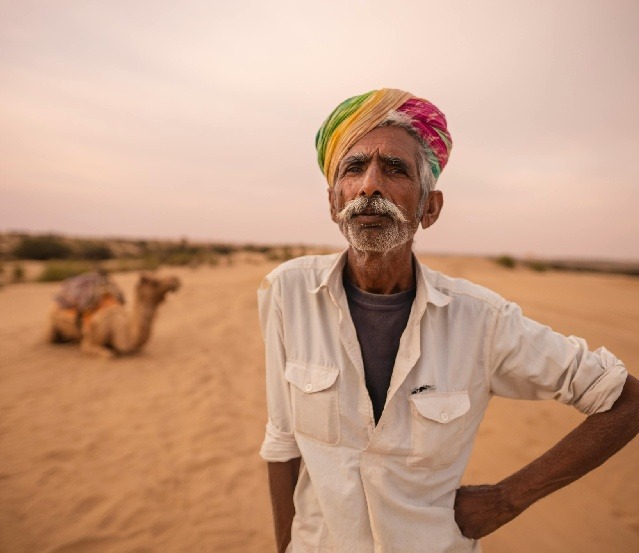
Rajasthan, located in the northwestern part of India, is the largest state by area, covering approximately 342,239 square kilometers. The state is characterized by diverse geography, including the Thar Desert, the Aravalli mountain range, and fertile plains.
As of the latest census, Rajasthan has a population of around 80 million people, making it one of the most populous states in India. The literacy rate in Rajasthan stands at approximately 66%, reflecting ongoing efforts to improve education.
The state’s rich cultural heritage and historical significance attract millions of tourists each year.
Rajasthan Tour Packages
More Tour Packages : Rajasthan Tour Packages, Best Time to Visit Rajasthan, How To reach Rajasthan, Delhi Rajasthan, Rajasthan Tour Packages, Rajasthan day tour package, Famous Places in Rajasthan, Rajasthan History, Famous Food Of Rajasthan, Rajasthan holiday package, Rajasthan Sightseeing
Destinations
Head Office
L-2 Shaheed Nagar
282001- Agra
Get In Touch
Call Us 8006635383
tourazalea@gmail.com
Based On 1630 Reviews

